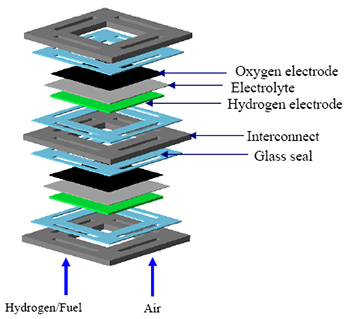May 24 2009
Solid oxide fuel cells (SOFCs) have great potential for stationary and mobile applications. Stationary use ranges from residential applications to power plants. Mobile applications include power for ships at sea and in space, as well as for autos. In addition to electricity, when SOFCs are operated in reverse mode as solid oxide electrolyzer cells, pure hydrogen can be generated by splitting water.
 This drawing shows the placement of the glass seals in the solid oxide fuel cells
This drawing shows the placement of the glass seals in the solid oxide fuel cells
But SOFCs have had a flaw – the integrity of the seals within and between power-producing units. "The seal problem is the biggest problem for commercialization of solid oxide fuel cells," said Peizhen (Kathy) Lu (http://www2.mse.vt.edu/People/Faculty/KLu/tabid/533/Default.aspx), assistant professor of materials science and engineering at Virginia Tech.
So she has invented a solution.
Composed of ceramic materials that can operate at temperatures as high as 1,800 degrees F (1,000 C), SOFCs use high temperature to separate oxygen ions from air. The ions pass through a crystal lattice and oxidize a fuel– usually a hydrocarbon. The chemical reaction produces electrons, which flow through an external circuit, creating electricity.
To produce enough energy for a particular application, SOFC modules are stacked together. Each module has air on one side and a fuel on the other side and produces electrons. Many modules are stacked together to produce enough power for specific applications. Each module's compartments must be sealed, and there must be seals between the modules in a stack so that air and fuel do not leak or mix, resulting in a loss of efficiency or internal combustion.
Lu has invented a new glass that can be used to seal the modules and the stack. The self-healing seal glass will provide strength and long-term stability to the stack, she said.
The U.S. Department of Energy has funded Lu's SOFC and solid oxide elecrolyzer cell research to the tune of $365,000 so far. "For solid oxide fuel cells to run, we need to have a fuel. Hydrogen is the cleanest fuel you can ever have since the by-product is water. However, there is no abundant source of hydrogen and it has to be made. The solid oxide elecrolyzer cell process for splitting water into hydrogen and oxygen is one very desirable way of doing it," Lu said.
"Our interest is to work on the critical material problems to enable power generation and hydrogen production in large quantity and low cost," said Lu, whose expertise includes material design and material synthesis and processing. (Learn more about her work at www.lu.mse.vt.edu)
"The invented glass seal materials are free of barium oxide, calcium oxide, magnesia, and alkali oxides, and in addition contain almost imperceptibly low amounts of boron oxide," said Mike Miller senior licensing manager with Virginia Tech Intellectual Properties. "This is important because the seals must be both mechanically and chemically compatible with the different oxide and metallic cell components as they are repeatedly cycled between room and operating temperatures,” said Miller.
An article relevant to her research, which appeared in the Oct. 6, 2008 issue of the Journal of Applied Physics is “Network structure and thermal stability study of high temperature seal glass,” by Lu and Virginia Tech materials science and engineering doctoral student M. K. Mahapatra of Egra, Purba Medinipur, India.